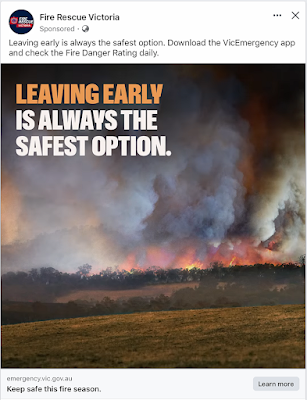People being virtually ordered from their homes and businesses in a broad-brush approach with seemingly little or no consideration of the actual vulnerability of those structures.
But first, Western Victoria, another example of how Victorians rely on the indefatigable CFA volunteers, with due respect to all the others involved in or supporting the firefight.
You might wonder why my interest in the Mountain Fire in Camarillo, California (Plate 1) but here's a story in The Washington Post 16 December 2024 about obtaining insurance for a family home that includes wildfire (bushfire in Australia if you prefer), certainly relevant in Australia. An extract from the story:
The small mountain town, a short drive from Lake Tahoe, offered the former preschool teacher and her husband, a carpenter, a shot at becoming middle class by escaping crushing housing costs near Santa Cruz, California.
“We moved up here for a better life,” she said in a phone interview. “For two or three years, we got that taste.” The small mountain town, a short drive from Lake Tahoe, offered the former preschool teacher and her husband, a carpenter, a shot at becoming middle class by escaping crushing housing costs near Santa Cruz, California. “We moved up here for a better life,” she said in a phone interview. “For two or three years, we got that taste.”
Then the insurance bills came. In 2017, the couple paid $1,100 to insure their small cabin. But since then, nine of California’s 10 largest wildfires have erupted, sending the insurance market into turmoil. Three insurers have dropped her in three years. This year, a basic policy from the public FAIR plan, the state-run insurer of last resort, and supplemental private insurance will cost Temple $6,000. It’s likely to rise again. “Now we’re back to watching each paycheck,” she said, “and budgeting for everything.”
Temple is among the many Americans watching their hold on homeownership slip away as insurance costs balloon beyond their ability to pay. “This is our first house. I don’t want to leave,” said Temple, struggling to keep her composure. “I try not to look too far into the future. I get scared.”
Insuring your home has never been harder. Here’s how to do it.
AUSTRALIA
Difficulties in obtaining insurance associated with bushfire risk is also being experienced in Australia. From Bellrock:
and
If underwriting losses exceed returns, insurers will cease to provide insurance cover at an affordable price. We have already witnessed this in parts of the world such as the USA where cover for bushfire in parts of California is unavailable except via a state scheme known as The California Fair Access to Insurance Requirements (FAIR). That scheme provides very basic last resort cover at a very high price point. Government in Australia, at all levels, is hesitant to provide any such scheme as they themselves are already carrying significant exposure on their own property portfolio.
Important to consider the one-size-fits-all leave early policy and ask the question; how many homes and businesses have been otherwise avoidably lost as a result and can it be improved? Indeed, what is the basis of the advice?
Then there’s the posting of warnings. It must have been confusing, indeed frightening for some as the plethora of warnings and areas they applied to were issued over days. Again, can it be improved?
Responsibility and accountability
Extract from an ABC story:
Victorian Premier Jacinta Allan said she was focused on supporting emergency services and communities affected by the bushfires, rather than division within the Liberal Party room.
"We're two days after Christmas and we see the Liberal Party focused on their disunity and lack of trust in each other — that's for them," she told 3AW. "I'm focused on our Victorians who are under fire threat and supporting our emergency services.
"I cannot emphasise enough how what is going on in the Liberal Party party room, two days after Christmas while parts of the state are under fire risk, is very much a matter for them."
30 December 2024. Part of the 'smokescreen'.
Extract from an ABC storey:
Deakin University associate professor John White has studied how species and ecosystems respond to external threats such as fire and climate change, particularly in the Grampians, since 2008.
Dr White expected the devastation caused by the fire to be felt for many years.
"This is about the fourth large fire in the Grampians in the past 20 years, which is a lot more than normal," he said.
Premier Allan, need I remind you that there is a Minister in your government responsible for as near as practicable risk-free management of the Grampians National Park, which must include protection of the adjoining landholders? Looks like failure to me and no doubt many others.
Whatever happened to continiual improvement that in modern history should have been benchmarked on the recommendations in the 2009 Victorian Bushfires Royal Commission, which included fuel management!




No comments:
Post a Comment